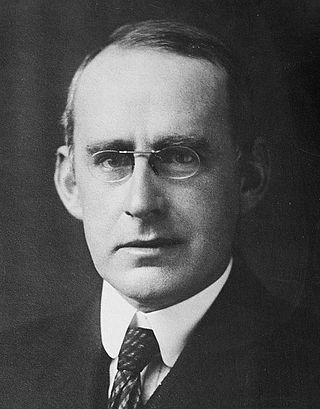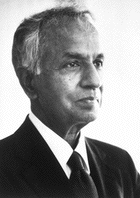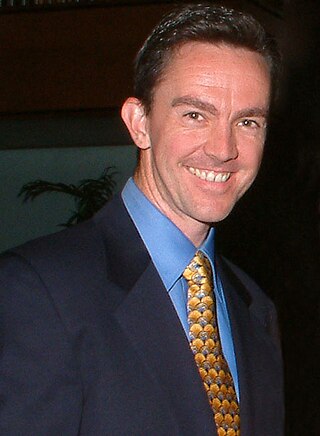
Sir Arthur Stanley Eddington was an English astronomer, physicist, and mathematician. He was also a philosopher of science and a populariser of science. The Eddington limit, the natural limit to the luminosity of stars, or the radiation generated by accretion onto a compact object, is named in his honour.

A star is an astronomical object comprising a luminous spheroid of plasma held together by self-gravity. The nearest star to Earth is the Sun. Many other stars are visible to the naked eye at night, but their immense distances from Earth make them appear as fixed points of light. The most prominent stars have been categorised into constellations and asterisms, and many of the brightest stars have proper names. Astronomers have assembled star catalogues that identify the known stars and provide standardized stellar designations. The observable universe contains an estimated 1022 to 1024 stars. Only about 4,000 of these stars are visible to the naked eye, all within the Milky Way galaxy.

Astronomy is a natural science that studies celestial objects and phenomena. It uses mathematics, physics, and chemistry in order to explain their origin and evolution. Objects of interest include planets, moons, stars, nebulae, galaxies, and comets. Relevant phenomena include supernova explosions, gamma ray bursts, quasars, blazars, pulsars, and cosmic microwave background radiation. More generally, astronomy studies everything that originates beyond Earth's atmosphere. Cosmology is a branch of astronomy that studies the universe as a whole.

Subrahmanyan Chandrasekhar was an Indian-American theoretical physicist who spent his professional life in the United States. He shared the 1983 Nobel Prize for Physics with William A. Fowler for "...theoretical studies of the physical processes of importance to the structure and evolution of the stars". His mathematical treatment of stellar evolution yielded many of the current theoretical models of the later evolutionary stages of massive stars and black holes. Many concepts, institutions, and inventions, including the Chandrasekhar limit and the Chandra X-Ray Observatory, are named after him.
The carbon-burning process or carbon fusion is a set of nuclear fusion reactions that take place in the cores of massive stars (at least 8 at birth) that combines carbon into other elements. It requires high temperatures (> 5×108 K or 50 keV) and densities (> 3×109 kg/m3).
Astrophysics is a science that employs the methods and principles of physics and chemistry in the study of astronomical objects and phenomena. As one of the founders of the discipline, James Keeler, said, Astrophysics "seeks to ascertain the nature of the heavenly bodies, rather than their positions or motions in space–what they are, rather than where they are." Among the subjects studied are the Sun, other stars, galaxies, extrasolar planets, the interstellar medium and the cosmic microwave background. Emissions from these objects are examined across all parts of the electromagnetic spectrum, and the properties examined include luminosity, density, temperature, and chemical composition. Because astrophysics is a very broad subject, astrophysicists apply concepts and methods from many disciplines of physics, including classical mechanics, electromagnetism, statistical mechanics, thermodynamics, quantum mechanics, relativity, nuclear and particle physics, and atomic and molecular physics.

Didier Patrick Queloz is a Swiss astronomer. He is the Jacksonian Professor of Natural Philosophy at the University of Cambridge, where he is also a fellow of Trinity College, Cambridge, as well as a professor at the University of Geneva. Together with Michel Mayor in 1995, he discovered 51 Pegasi b, the first extrasolar planet orbiting a Sun-like star, 51 Pegasi. For this discovery, he shared the 2019 Nobel Prize in Physics with Mayor and Jim Peebles. In 2021, he was announced as the founding director of the Center for the Origin and Prevalence of Life at ETH Zurich.

The following outline is provided as an overview of and topical guide to astronomy:
Dame Carole Jordan, is a British physicist, astrophysicist, astronomer and academic. Currently, she is Professor Emeritus of Astrophysics at the University of Oxford and Emeritus Fellow at Somerville College, Oxford. From 1994 to 1996, she was President of the Royal Astronomical Society; she was the first woman to hold this appointment. She won the Gold Medal of the Royal Astronomical Society in 2005; she was only the third female recipient following Caroline Herschel in 1828 and Vera Rubin in 1996. She was head of the Rudolf Peierls Centre for Theoretical Physics at the University of Oxford from 2003 to 2004 and 2005 to 2008, and was one of the first female professors in Astronomy in Britain. She was made a Dame Commander of the Order of the British Empire in 2006 for services to physics and astronomy.
Alastair G. W. Cameron was an American-Canadian astrophysicist and space scientist who was an eminent staff member of the Astronomy department of Harvard University. He was one of the founders of the field of nuclear astrophysics, advanced the theory that the Moon was created by the giant impact of a Mars-sized object with the early Earth, and was an early adopter of computer technology in astrophysics.
In astronomy, the bolometric correction is the correction made to the absolute magnitude of an object in order to convert its visible magnitude to its bolometric magnitude. It is large for stars which radiate most of their energy outside of the visible range. A uniform scale for the correction has not yet been standardized.
Charles Thomas Bolton was an American-Canadian astronomer who was one of the first in his field to present strong evidence of the existence of a stellar-mass black hole.
Adam Frank is an American physicist, astronomer, and writer. His scientific research has focused on computational astrophysics with an emphasis on star formation and late stages of stellar evolution. His work includes studies of exoplanet atmospheres and astrobiology. The latter include studies of the generic response of planets to the evolution of energy-intensive civilizations (exo-civilizations).

J. Davy Kirkpatrick is an American astronomer at the Infrared Processing and Analysis Center at the California Institute of Technology in Pasadena, California. Kirkpatrick's research was named one of the top ten science accomplishments of the first ten years (1992–2002) of the W. M. Keck Observatory and one of the Top 100 Stories of 2011 by Discover Magazine.

HD 140283 is a metal-poor subgiant star about 190 light years away from the Earth in the constellation Libra, near the boundary with Ophiuchus in the Milky Way Galaxy. Its apparent magnitude is 7.205, so it can be seen with binoculars. It is one of the oldest stars known. The star's light is somewhat blueshifted as it is moving toward rather than away from the Earth and it has been known to astronomers for over a century as a high-velocity star based on its other vectors. An early spectroscopic analysis by Joseph W. Chamberlain and Lawrence Aller revealed it to have a substantially lower metal content than the Sun. Modern spectroscopic analyses find an iron content about a factor of 250 lower than that of the Sun. It is one of the closest metal-poor (Population II) stars to Earth.

Sidney Carne Wolff is an American astrophysicist, researcher, public educator, and author. She is the first woman in the United States to head a major observatory, and she provided significant contributions to the construction of six telescopes. Wolff served as Director of the Kitt Peak National Observatory (KPNO) and the National Optical Astronomy Observatory (NOAO). She is a member of the International Astronomical Union's Division G: Stars and Stellar Physics.
Jennifer Hoffman is an American astrophysicist and associate professor at the University of Denver. She studies the circumstellar material around stars.
Claudia Maraston is a Professor of Astrophysics at the University of Portsmouth. She designs models for the calculation of spectro-photometric evolution of stellar populations. She is the winner of the 2018 Royal Astronomical Society Eddington Medal.

Kim A. Venn is a professor of physics and astronomy at the University of Victoria, Canada, and director of the university's Astronomy Research Centre. She researches the chemo-dynamical analysis of stars in the galaxy and its nearby dwarf satellites.
Gilles Fontaine was a professor of astrophysics at the Université de Montréal in Quebec, Canada.









